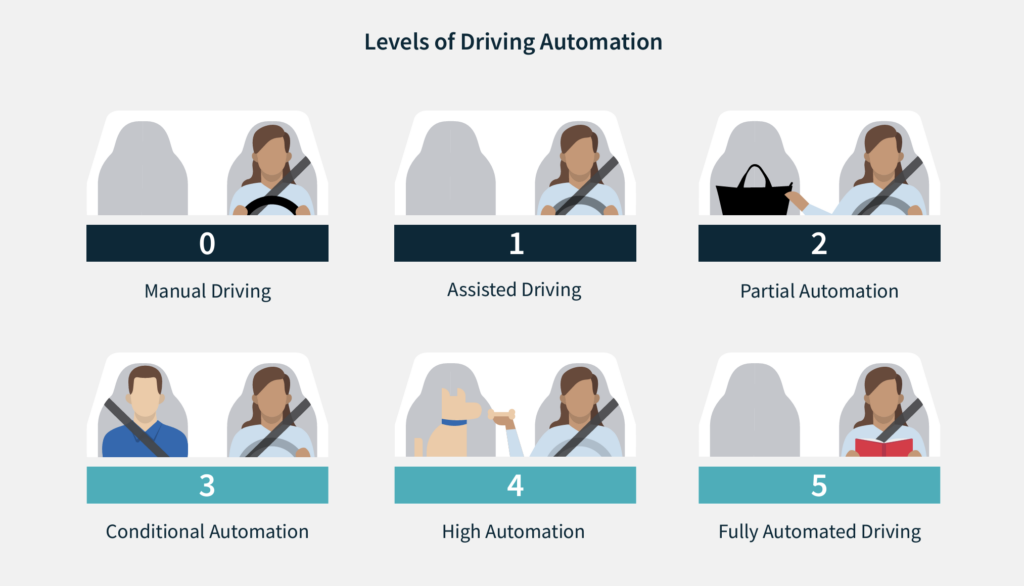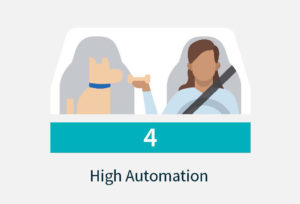What’s the number one question Torc’rs get asked? “When will your trucks fully reach Level 5 autonomy?” Humans like to think in the binary. Either you’re driving the vehicle, or you’re not driving the vehicle. But it is not so black and white when it comes to autonomous vehicles.
The SAE – the Society of Automotive Engineers International — has defined autonomous driving into six different levels. Only Level 5 is fully autonomous, to the point of theoretically being able to handle every driving situation that you could imagine, in every location in the world, without any human interaction or supervision needed.
Within the parameters of the 21st century, the software needed to create fully deployable Level 5, not to mention commercially viable vehicles, are science fiction.
Level 4, just a step under that, is reality. It is, in fact, the science versus science fiction.

What’s the difference between Level 4 autonomy and Level 5 autonomy?
The nuances between Level 5 and Level 4 are distinct and important. Understanding them is key to differentiating between the real and the fantasy.
Level 5 autonomy is where most imaginations run to when they hear “self-driving.” It is fully and completely autonomous. There is no need for a steering wheel, and all people are passengers. But that simplicity of Level 5 would require an astronomical amount of technological development, maintenance, and testing.
For a fully realized Level 5 instance, the autonomous driving system would have to navigate everywhere. Every drivable surface, from gravel roads to back-alleyways would need to be mapped and remapped. Situations that the vehicle would be able to handle would include everything from unmarked roads and new pop-up roadworks to a tornado dropping out of the clouds, as aliens land, and Godzilla starts attacking. The definition of Level 5 includes the autonomous vehicle making the right decisions in all those situations without complaint. In other words, an android would be driving the vehicle; there would be zero human intervention involved.
It is science fiction. Does that mean it will not happen? Maybe. However, Level 5 autonomous trucks are not a viable, achievable, accessible product for the 4.19 million miles of U.S. roads. And those vehicles, and that freight market, is what Torc is focused on.
Torc’s Focused Approach
Level 4, however, stays just slightly over that line of science fiction into science fact. Torc’s autonomous driving system can navigate without human intervention within environmental, route, or traffic scenario limits. The limits put on the expected or allowed performance of the trucks are defined in the system’s Operational Design Domain or (ODD). Within these factors, the autonomous truck can navigate the road ahead in defined situations. Importantly, Level 4 can be an autonomous product that can be realistically foreseen, programmed, tested, and viable. That is Level 4, a high automation drive.
We state the Whys to Level 4 Autonomous Trucking plan in our Safety Report:
Torc is working toward building a level 4 truck because we believe that this level of driving automation will be the safest for heavy-duty trucks and will offer enormous advantages in many areas.
Level 4 trucks will:
- Make significant contributions toward safer roads and more sustainable transport solutions;
- Enhance traffic safety thanks to a redundancy of systems and multiple sensors that can consistently achieve high performance – thereby helping to prevent the great majority of crashes that today result from human error;
- Improve efficiency and productivity by, among other avenues, higher utilization of the vehicles – practically around the clock;
- Avoid traffic jams by intelligent route management, making it possible to travel during light traffic times.

Level 5 Autonomy is Always Everywhere
Is Level 5 autonomy possible? The answer is complicated. For answers, we turned to Axel Gern, chief technology officer of Torc’s technology and software development center in Stuttgart, Germany. “Level 5 automation means, in my definition, always everywhere,” says Axel. “It needs to make safe decisions when you’re driving through the desert in Africa, or in the middle of Bangalore. But do we need to drive there autonomously? No, not right now.”
“Level 5 autonomy puts a lot of work and focus on these things, to achieve a safe system that is able to drive everywhere, every time,” Gern continues. “Level 4, when you start to restrict the scope, understanding the limits and living within those limits, is perfectly fine. When you basically cover the situation to at least a safe condition, what is called minimal risk condition or MRC, that is what’s useful. Anything else is a huge challenge. Level 4 autonomy, in the way Torc defines it, is approachable and doable.”
For the trucking and the freight logistics industry, Level 4 is the most appropriate and realistic. It is also, strategically, the safest level, and since the beginning of our company, safety and saving lives has been our work’s core mission.
At Torc, our mission is to create a scalable, commercially viable autonomous trucking product that will address the practical needs of the freight industry. We will leave fighting off Godzilla to our science fiction fans.
